Unit 5: Management Accounting Application in Marks & Spencer
VerifiedAdded on 2023/01/11
|17
|4669
|56
Report
AI Summary
This report delves into the application of management accounting principles within Marks & Spencer, a prominent international retail organization. It examines the role of management accounting in enhancing organizational performance, highlighting the importance of cost accounting systems, inventory management, job costing methods, and price optimization systems. The report further explores various management accounting techniques such as marginal costing and absorption costing. It also discusses the essential requirements of management accounting systems and analyzes different management reporting methods, including budget reports, cost reports, performance reports, and inventory reports. The study emphasizes how Marks & Spencer can adapt its management accounting systems to effectively respond to financial challenges and improve overall operational efficiency. This detailed analysis provides valuable insights into the practical application of management accounting in the retail sector. Desklib provides access to a wealth of similar student-contributed documents and AI-powered study tools.
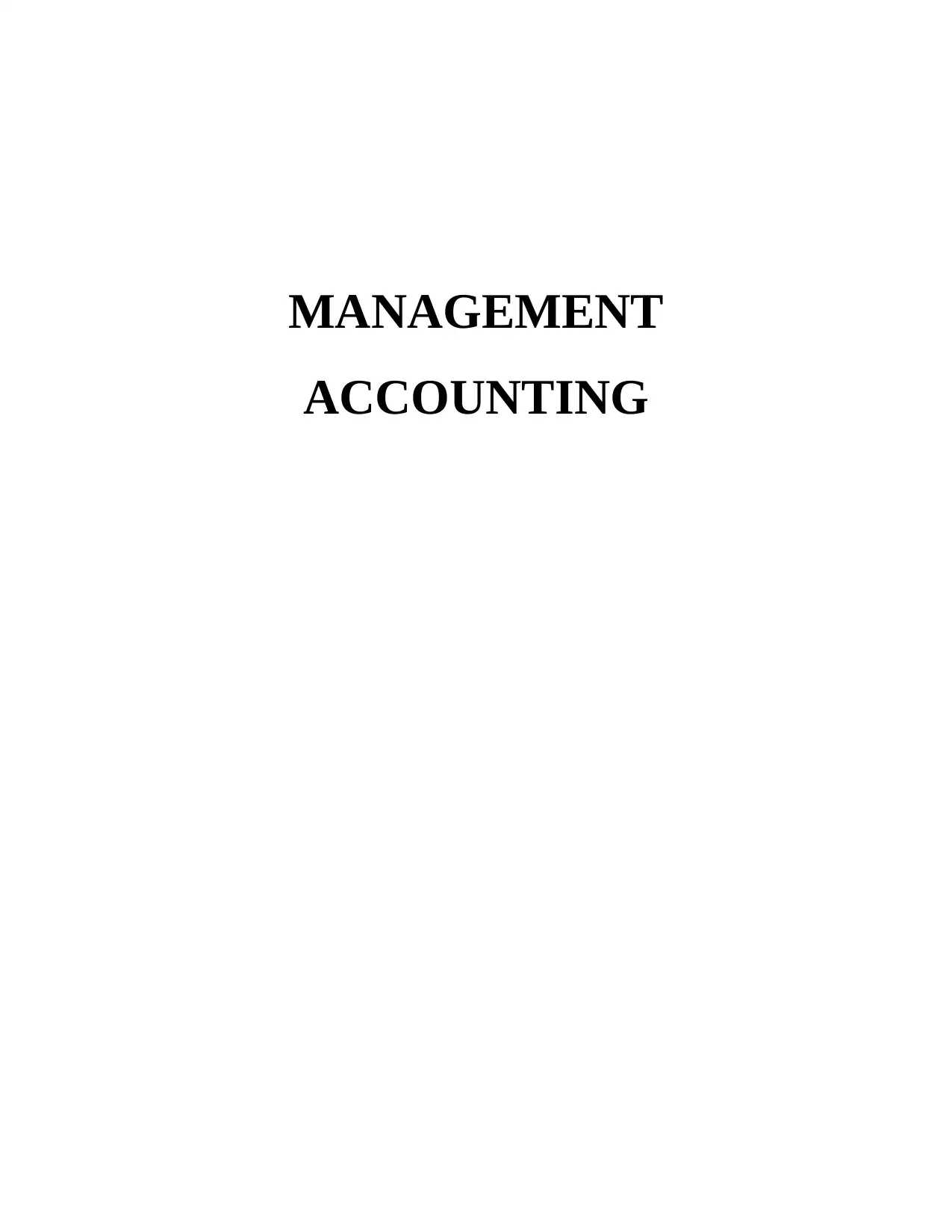
MANAGEMENT
ACCOUNTING
ACCOUNTING
Paraphrase This Document
Need a fresh take? Get an instant paraphrase of this document with our AI Paraphraser
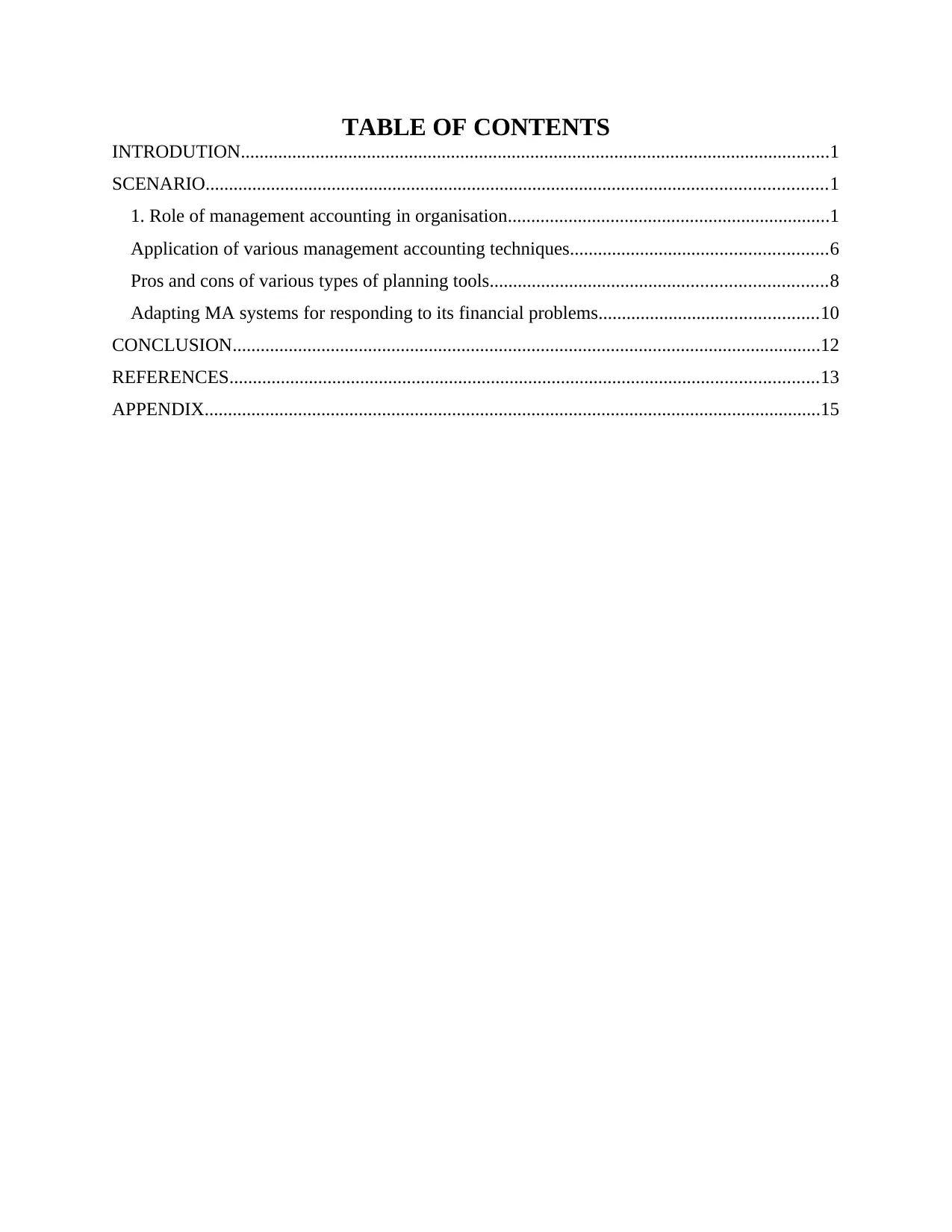
TABLE OF CONTENTS
INTRODUTION..............................................................................................................................1
SCENARIO.....................................................................................................................................1
1. Role of management accounting in organisation.....................................................................1
Application of various management accounting techniques.......................................................6
Pros and cons of various types of planning tools........................................................................8
Adapting MA systems for responding to its financial problems...............................................10
CONCLUSION..............................................................................................................................12
REFERENCES..............................................................................................................................13
APPENDIX....................................................................................................................................15
INTRODUTION..............................................................................................................................1
SCENARIO.....................................................................................................................................1
1. Role of management accounting in organisation.....................................................................1
Application of various management accounting techniques.......................................................6
Pros and cons of various types of planning tools........................................................................8
Adapting MA systems for responding to its financial problems...............................................10
CONCLUSION..............................................................................................................................12
REFERENCES..............................................................................................................................13
APPENDIX....................................................................................................................................15
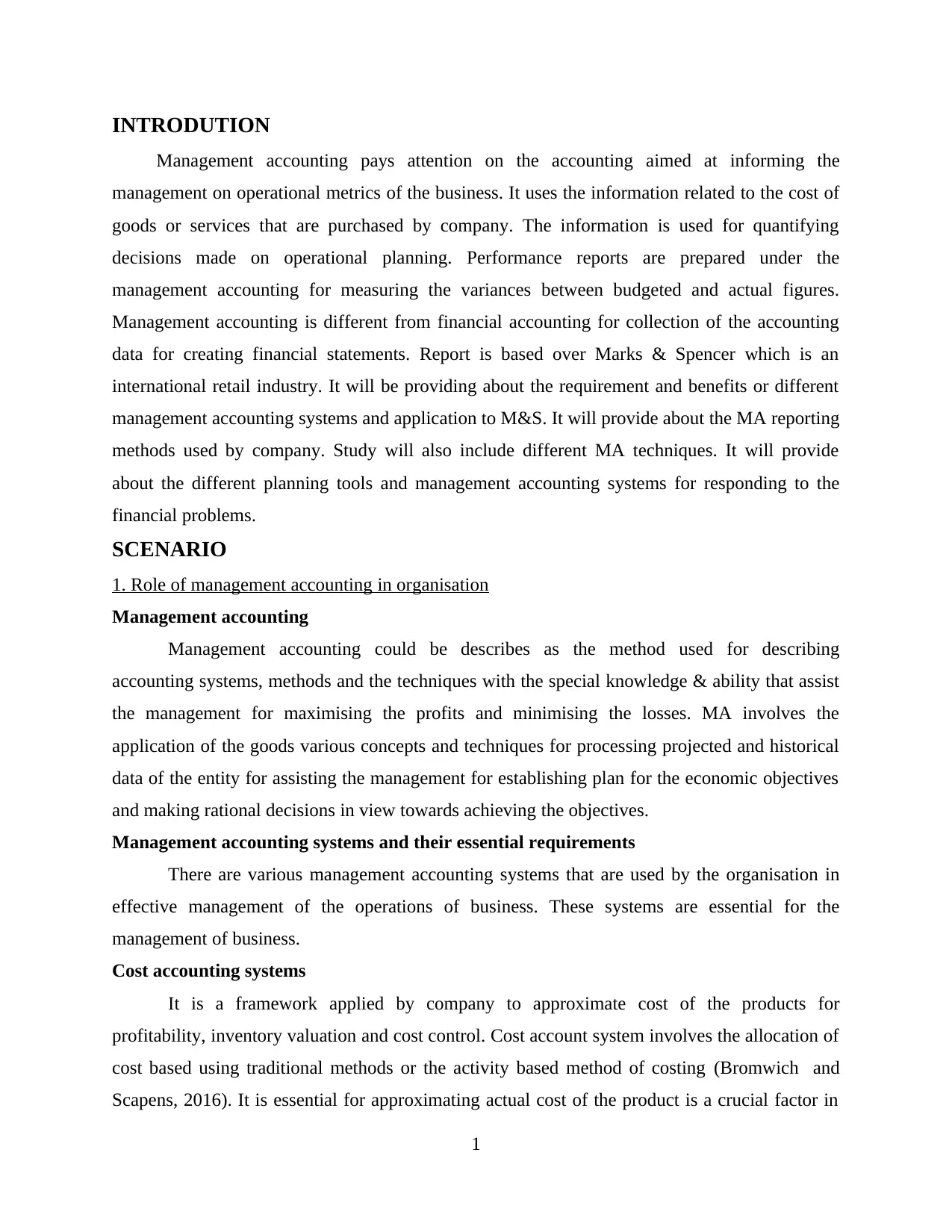
INTRODUTION
Management accounting pays attention on the accounting aimed at informing the
management on operational metrics of the business. It uses the information related to the cost of
goods or services that are purchased by company. The information is used for quantifying
decisions made on operational planning. Performance reports are prepared under the
management accounting for measuring the variances between budgeted and actual figures.
Management accounting is different from financial accounting for collection of the accounting
data for creating financial statements. Report is based over Marks & Spencer which is an
international retail industry. It will be providing about the requirement and benefits or different
management accounting systems and application to M&S. It will provide about the MA reporting
methods used by company. Study will also include different MA techniques. It will provide
about the different planning tools and management accounting systems for responding to the
financial problems.
SCENARIO
1. Role of management accounting in organisation
Management accounting
Management accounting could be describes as the method used for describing
accounting systems, methods and the techniques with the special knowledge & ability that assist
the management for maximising the profits and minimising the losses. MA involves the
application of the goods various concepts and techniques for processing projected and historical
data of the entity for assisting the management for establishing plan for the economic objectives
and making rational decisions in view towards achieving the objectives.
Management accounting systems and their essential requirements
There are various management accounting systems that are used by the organisation in
effective management of the operations of business. These systems are essential for the
management of business.
Cost accounting systems
It is a framework applied by company to approximate cost of the products for
profitability, inventory valuation and cost control. Cost account system involves the allocation of
cost based using traditional methods or the activity based method of costing (Bromwich and
Scapens, 2016). It is essential for approximating actual cost of the product is a crucial factor in
1
Management accounting pays attention on the accounting aimed at informing the
management on operational metrics of the business. It uses the information related to the cost of
goods or services that are purchased by company. The information is used for quantifying
decisions made on operational planning. Performance reports are prepared under the
management accounting for measuring the variances between budgeted and actual figures.
Management accounting is different from financial accounting for collection of the accounting
data for creating financial statements. Report is based over Marks & Spencer which is an
international retail industry. It will be providing about the requirement and benefits or different
management accounting systems and application to M&S. It will provide about the MA reporting
methods used by company. Study will also include different MA techniques. It will provide
about the different planning tools and management accounting systems for responding to the
financial problems.
SCENARIO
1. Role of management accounting in organisation
Management accounting
Management accounting could be describes as the method used for describing
accounting systems, methods and the techniques with the special knowledge & ability that assist
the management for maximising the profits and minimising the losses. MA involves the
application of the goods various concepts and techniques for processing projected and historical
data of the entity for assisting the management for establishing plan for the economic objectives
and making rational decisions in view towards achieving the objectives.
Management accounting systems and their essential requirements
There are various management accounting systems that are used by the organisation in
effective management of the operations of business. These systems are essential for the
management of business.
Cost accounting systems
It is a framework applied by company to approximate cost of the products for
profitability, inventory valuation and cost control. Cost account system involves the allocation of
cost based using traditional methods or the activity based method of costing (Bromwich and
Scapens, 2016). It is essential for approximating actual cost of the product is a crucial factor in
1
⊘ This is a preview!⊘
Do you want full access?
Subscribe today to unlock all pages.

Trusted by 1+ million students worldwide
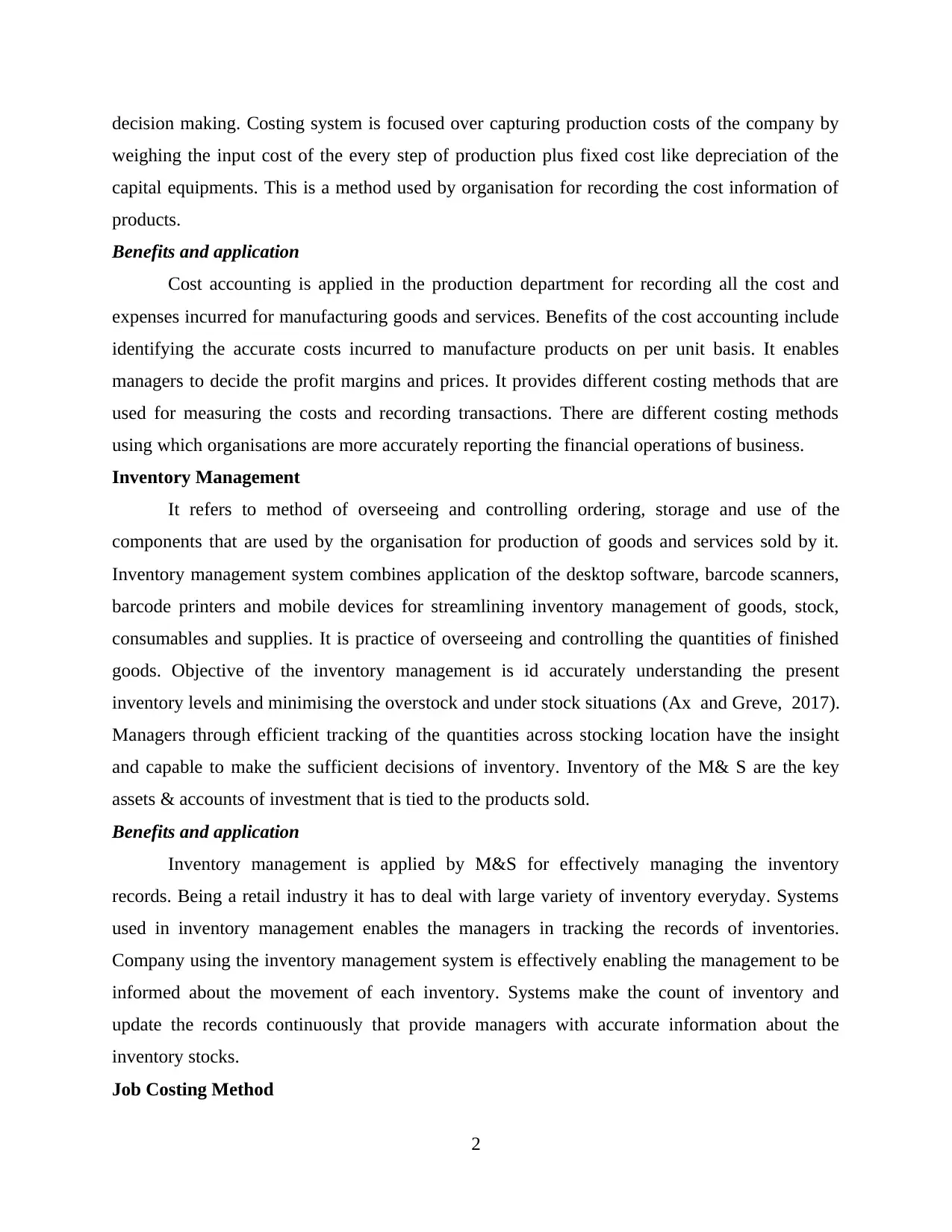
decision making. Costing system is focused over capturing production costs of the company by
weighing the input cost of the every step of production plus fixed cost like depreciation of the
capital equipments. This is a method used by organisation for recording the cost information of
products.
Benefits and application
Cost accounting is applied in the production department for recording all the cost and
expenses incurred for manufacturing goods and services. Benefits of the cost accounting include
identifying the accurate costs incurred to manufacture products on per unit basis. It enables
managers to decide the profit margins and prices. It provides different costing methods that are
used for measuring the costs and recording transactions. There are different costing methods
using which organisations are more accurately reporting the financial operations of business.
Inventory Management
It refers to method of overseeing and controlling ordering, storage and use of the
components that are used by the organisation for production of goods and services sold by it.
Inventory management system combines application of the desktop software, barcode scanners,
barcode printers and mobile devices for streamlining inventory management of goods, stock,
consumables and supplies. It is practice of overseeing and controlling the quantities of finished
goods. Objective of the inventory management is id accurately understanding the present
inventory levels and minimising the overstock and under stock situations (Ax and Greve, 2017).
Managers through efficient tracking of the quantities across stocking location have the insight
and capable to make the sufficient decisions of inventory. Inventory of the M& S are the key
assets & accounts of investment that is tied to the products sold.
Benefits and application
Inventory management is applied by M&S for effectively managing the inventory
records. Being a retail industry it has to deal with large variety of inventory everyday. Systems
used in inventory management enables the managers in tracking the records of inventories.
Company using the inventory management system is effectively enabling the management to be
informed about the movement of each inventory. Systems make the count of inventory and
update the records continuously that provide managers with accurate information about the
inventory stocks.
Job Costing Method
2
weighing the input cost of the every step of production plus fixed cost like depreciation of the
capital equipments. This is a method used by organisation for recording the cost information of
products.
Benefits and application
Cost accounting is applied in the production department for recording all the cost and
expenses incurred for manufacturing goods and services. Benefits of the cost accounting include
identifying the accurate costs incurred to manufacture products on per unit basis. It enables
managers to decide the profit margins and prices. It provides different costing methods that are
used for measuring the costs and recording transactions. There are different costing methods
using which organisations are more accurately reporting the financial operations of business.
Inventory Management
It refers to method of overseeing and controlling ordering, storage and use of the
components that are used by the organisation for production of goods and services sold by it.
Inventory management system combines application of the desktop software, barcode scanners,
barcode printers and mobile devices for streamlining inventory management of goods, stock,
consumables and supplies. It is practice of overseeing and controlling the quantities of finished
goods. Objective of the inventory management is id accurately understanding the present
inventory levels and minimising the overstock and under stock situations (Ax and Greve, 2017).
Managers through efficient tracking of the quantities across stocking location have the insight
and capable to make the sufficient decisions of inventory. Inventory of the M& S are the key
assets & accounts of investment that is tied to the products sold.
Benefits and application
Inventory management is applied by M&S for effectively managing the inventory
records. Being a retail industry it has to deal with large variety of inventory everyday. Systems
used in inventory management enables the managers in tracking the records of inventories.
Company using the inventory management system is effectively enabling the management to be
informed about the movement of each inventory. Systems make the count of inventory and
update the records continuously that provide managers with accurate information about the
inventory stocks.
Job Costing Method
2
Paraphrase This Document
Need a fresh take? Get an instant paraphrase of this document with our AI Paraphraser
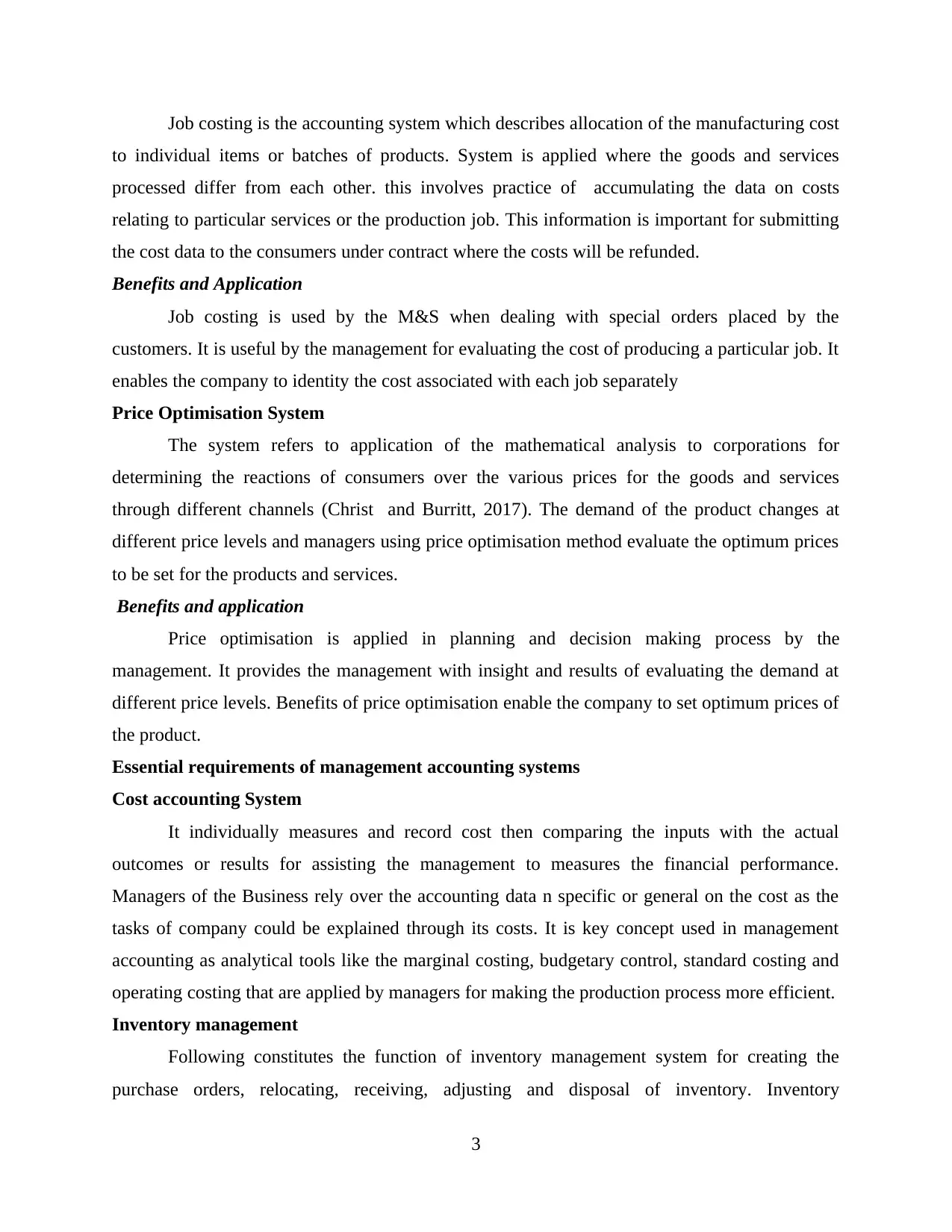
Job costing is the accounting system which describes allocation of the manufacturing cost
to individual items or batches of products. System is applied where the goods and services
processed differ from each other. this involves practice of accumulating the data on costs
relating to particular services or the production job. This information is important for submitting
the cost data to the consumers under contract where the costs will be refunded.
Benefits and Application
Job costing is used by the M&S when dealing with special orders placed by the
customers. It is useful by the management for evaluating the cost of producing a particular job. It
enables the company to identity the cost associated with each job separately
Price Optimisation System
The system refers to application of the mathematical analysis to corporations for
determining the reactions of consumers over the various prices for the goods and services
through different channels (Christ and Burritt, 2017). The demand of the product changes at
different price levels and managers using price optimisation method evaluate the optimum prices
to be set for the products and services.
Benefits and application
Price optimisation is applied in planning and decision making process by the
management. It provides the management with insight and results of evaluating the demand at
different price levels. Benefits of price optimisation enable the company to set optimum prices of
the product.
Essential requirements of management accounting systems
Cost accounting System
It individually measures and record cost then comparing the inputs with the actual
outcomes or results for assisting the management to measures the financial performance.
Managers of the Business rely over the accounting data n specific or general on the cost as the
tasks of company could be explained through its costs. It is key concept used in management
accounting as analytical tools like the marginal costing, budgetary control, standard costing and
operating costing that are applied by managers for making the production process more efficient.
Inventory management
Following constitutes the function of inventory management system for creating the
purchase orders, relocating, receiving, adjusting and disposal of inventory. Inventory
3
to individual items or batches of products. System is applied where the goods and services
processed differ from each other. this involves practice of accumulating the data on costs
relating to particular services or the production job. This information is important for submitting
the cost data to the consumers under contract where the costs will be refunded.
Benefits and Application
Job costing is used by the M&S when dealing with special orders placed by the
customers. It is useful by the management for evaluating the cost of producing a particular job. It
enables the company to identity the cost associated with each job separately
Price Optimisation System
The system refers to application of the mathematical analysis to corporations for
determining the reactions of consumers over the various prices for the goods and services
through different channels (Christ and Burritt, 2017). The demand of the product changes at
different price levels and managers using price optimisation method evaluate the optimum prices
to be set for the products and services.
Benefits and application
Price optimisation is applied in planning and decision making process by the
management. It provides the management with insight and results of evaluating the demand at
different price levels. Benefits of price optimisation enable the company to set optimum prices of
the product.
Essential requirements of management accounting systems
Cost accounting System
It individually measures and record cost then comparing the inputs with the actual
outcomes or results for assisting the management to measures the financial performance.
Managers of the Business rely over the accounting data n specific or general on the cost as the
tasks of company could be explained through its costs. It is key concept used in management
accounting as analytical tools like the marginal costing, budgetary control, standard costing and
operating costing that are applied by managers for making the production process more efficient.
Inventory management
Following constitutes the function of inventory management system for creating the
purchase orders, relocating, receiving, adjusting and disposal of inventory. Inventory
3
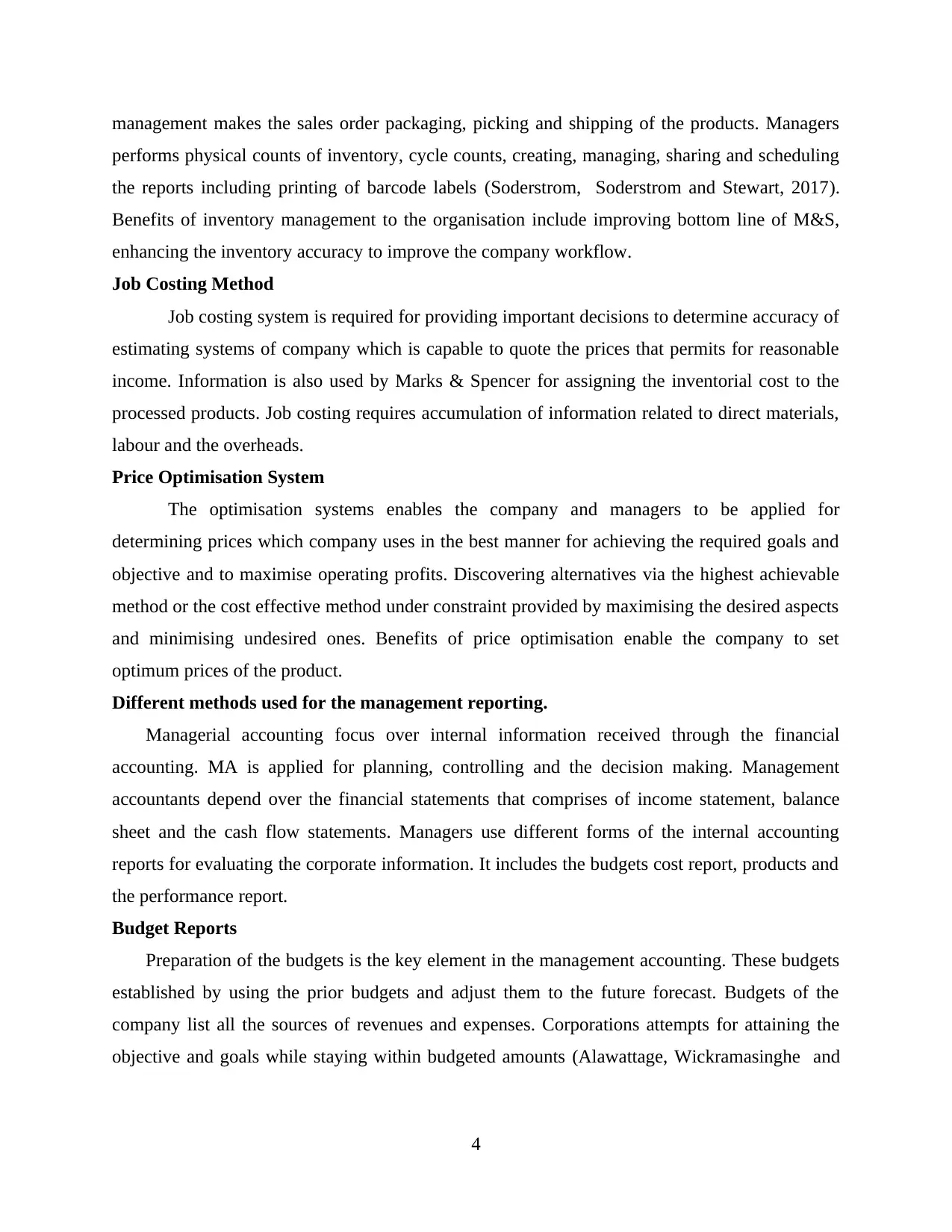
management makes the sales order packaging, picking and shipping of the products. Managers
performs physical counts of inventory, cycle counts, creating, managing, sharing and scheduling
the reports including printing of barcode labels (Soderstrom, Soderstrom and Stewart, 2017).
Benefits of inventory management to the organisation include improving bottom line of M&S,
enhancing the inventory accuracy to improve the company workflow.
Job Costing Method
Job costing system is required for providing important decisions to determine accuracy of
estimating systems of company which is capable to quote the prices that permits for reasonable
income. Information is also used by Marks & Spencer for assigning the inventorial cost to the
processed products. Job costing requires accumulation of information related to direct materials,
labour and the overheads.
Price Optimisation System
The optimisation systems enables the company and managers to be applied for
determining prices which company uses in the best manner for achieving the required goals and
objective and to maximise operating profits. Discovering alternatives via the highest achievable
method or the cost effective method under constraint provided by maximising the desired aspects
and minimising undesired ones. Benefits of price optimisation enable the company to set
optimum prices of the product.
Different methods used for the management reporting.
Managerial accounting focus over internal information received through the financial
accounting. MA is applied for planning, controlling and the decision making. Management
accountants depend over the financial statements that comprises of income statement, balance
sheet and the cash flow statements. Managers use different forms of the internal accounting
reports for evaluating the corporate information. It includes the budgets cost report, products and
the performance report.
Budget Reports
Preparation of the budgets is the key element in the management accounting. These budgets
established by using the prior budgets and adjust them to the future forecast. Budgets of the
company list all the sources of revenues and expenses. Corporations attempts for attaining the
objective and goals while staying within budgeted amounts (Alawattage, Wickramasinghe and
4
performs physical counts of inventory, cycle counts, creating, managing, sharing and scheduling
the reports including printing of barcode labels (Soderstrom, Soderstrom and Stewart, 2017).
Benefits of inventory management to the organisation include improving bottom line of M&S,
enhancing the inventory accuracy to improve the company workflow.
Job Costing Method
Job costing system is required for providing important decisions to determine accuracy of
estimating systems of company which is capable to quote the prices that permits for reasonable
income. Information is also used by Marks & Spencer for assigning the inventorial cost to the
processed products. Job costing requires accumulation of information related to direct materials,
labour and the overheads.
Price Optimisation System
The optimisation systems enables the company and managers to be applied for
determining prices which company uses in the best manner for achieving the required goals and
objective and to maximise operating profits. Discovering alternatives via the highest achievable
method or the cost effective method under constraint provided by maximising the desired aspects
and minimising undesired ones. Benefits of price optimisation enable the company to set
optimum prices of the product.
Different methods used for the management reporting.
Managerial accounting focus over internal information received through the financial
accounting. MA is applied for planning, controlling and the decision making. Management
accountants depend over the financial statements that comprises of income statement, balance
sheet and the cash flow statements. Managers use different forms of the internal accounting
reports for evaluating the corporate information. It includes the budgets cost report, products and
the performance report.
Budget Reports
Preparation of the budgets is the key element in the management accounting. These budgets
established by using the prior budgets and adjust them to the future forecast. Budgets of the
company list all the sources of revenues and expenses. Corporations attempts for attaining the
objective and goals while staying within budgeted amounts (Alawattage, Wickramasinghe and
4
⊘ This is a preview!⊘
Do you want full access?
Subscribe today to unlock all pages.

Trusted by 1+ million students worldwide
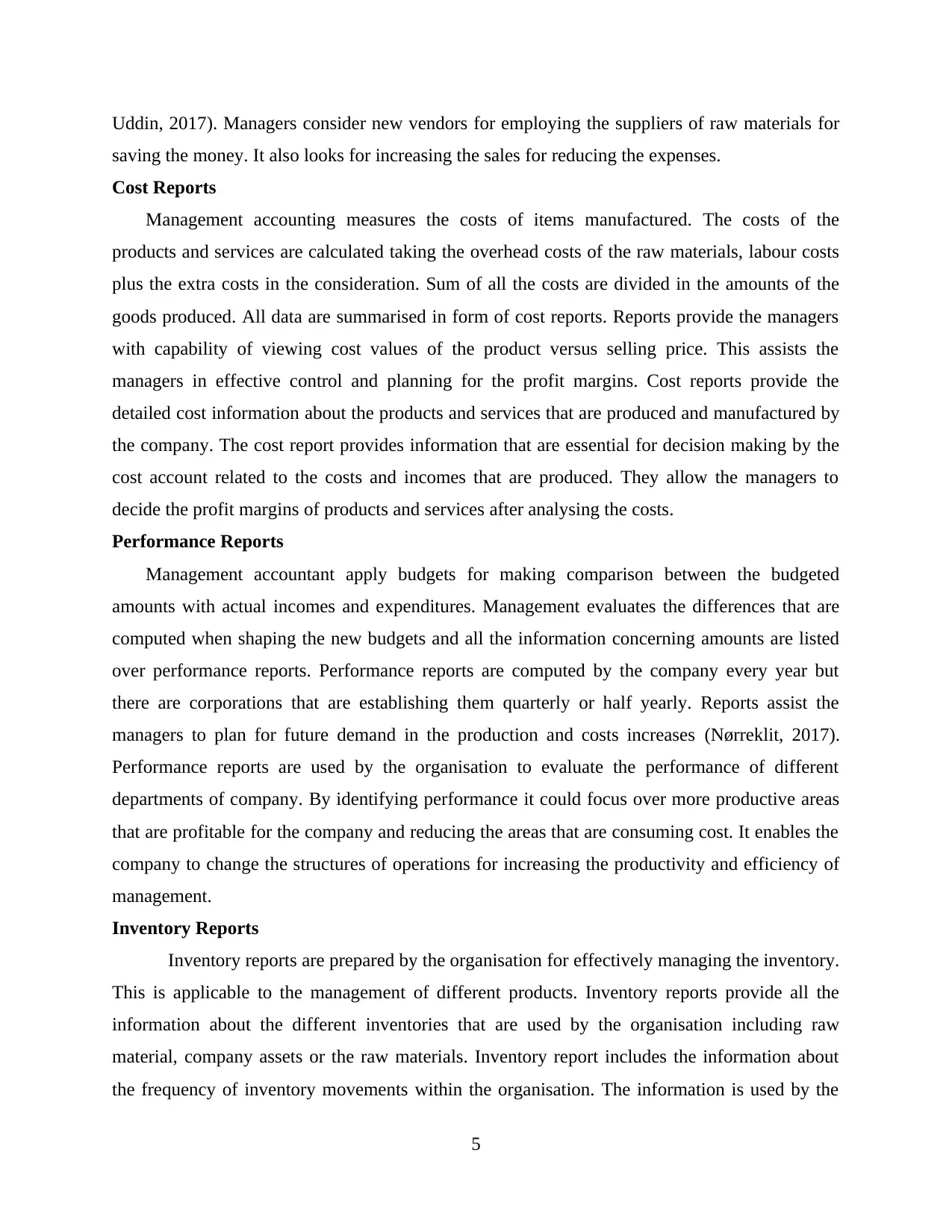
Uddin, 2017). Managers consider new vendors for employing the suppliers of raw materials for
saving the money. It also looks for increasing the sales for reducing the expenses.
Cost Reports
Management accounting measures the costs of items manufactured. The costs of the
products and services are calculated taking the overhead costs of the raw materials, labour costs
plus the extra costs in the consideration. Sum of all the costs are divided in the amounts of the
goods produced. All data are summarised in form of cost reports. Reports provide the managers
with capability of viewing cost values of the product versus selling price. This assists the
managers in effective control and planning for the profit margins. Cost reports provide the
detailed cost information about the products and services that are produced and manufactured by
the company. The cost report provides information that are essential for decision making by the
cost account related to the costs and incomes that are produced. They allow the managers to
decide the profit margins of products and services after analysing the costs.
Performance Reports
Management accountant apply budgets for making comparison between the budgeted
amounts with actual incomes and expenditures. Management evaluates the differences that are
computed when shaping the new budgets and all the information concerning amounts are listed
over performance reports. Performance reports are computed by the company every year but
there are corporations that are establishing them quarterly or half yearly. Reports assist the
managers to plan for future demand in the production and costs increases (Nørreklit, 2017).
Performance reports are used by the organisation to evaluate the performance of different
departments of company. By identifying performance it could focus over more productive areas
that are profitable for the company and reducing the areas that are consuming cost. It enables the
company to change the structures of operations for increasing the productivity and efficiency of
management.
Inventory Reports
Inventory reports are prepared by the organisation for effectively managing the inventory.
This is applicable to the management of different products. Inventory reports provide all the
information about the different inventories that are used by the organisation including raw
material, company assets or the raw materials. Inventory report includes the information about
the frequency of inventory movements within the organisation. The information is used by the
5
saving the money. It also looks for increasing the sales for reducing the expenses.
Cost Reports
Management accounting measures the costs of items manufactured. The costs of the
products and services are calculated taking the overhead costs of the raw materials, labour costs
plus the extra costs in the consideration. Sum of all the costs are divided in the amounts of the
goods produced. All data are summarised in form of cost reports. Reports provide the managers
with capability of viewing cost values of the product versus selling price. This assists the
managers in effective control and planning for the profit margins. Cost reports provide the
detailed cost information about the products and services that are produced and manufactured by
the company. The cost report provides information that are essential for decision making by the
cost account related to the costs and incomes that are produced. They allow the managers to
decide the profit margins of products and services after analysing the costs.
Performance Reports
Management accountant apply budgets for making comparison between the budgeted
amounts with actual incomes and expenditures. Management evaluates the differences that are
computed when shaping the new budgets and all the information concerning amounts are listed
over performance reports. Performance reports are computed by the company every year but
there are corporations that are establishing them quarterly or half yearly. Reports assist the
managers to plan for future demand in the production and costs increases (Nørreklit, 2017).
Performance reports are used by the organisation to evaluate the performance of different
departments of company. By identifying performance it could focus over more productive areas
that are profitable for the company and reducing the areas that are consuming cost. It enables the
company to change the structures of operations for increasing the productivity and efficiency of
management.
Inventory Reports
Inventory reports are prepared by the organisation for effectively managing the inventory.
This is applicable to the management of different products. Inventory reports provide all the
information about the different inventories that are used by the organisation including raw
material, company assets or the raw materials. Inventory report includes the information about
the frequency of inventory movements within the organisation. The information is used by the
5
Paraphrase This Document
Need a fresh take? Get an instant paraphrase of this document with our AI Paraphraser
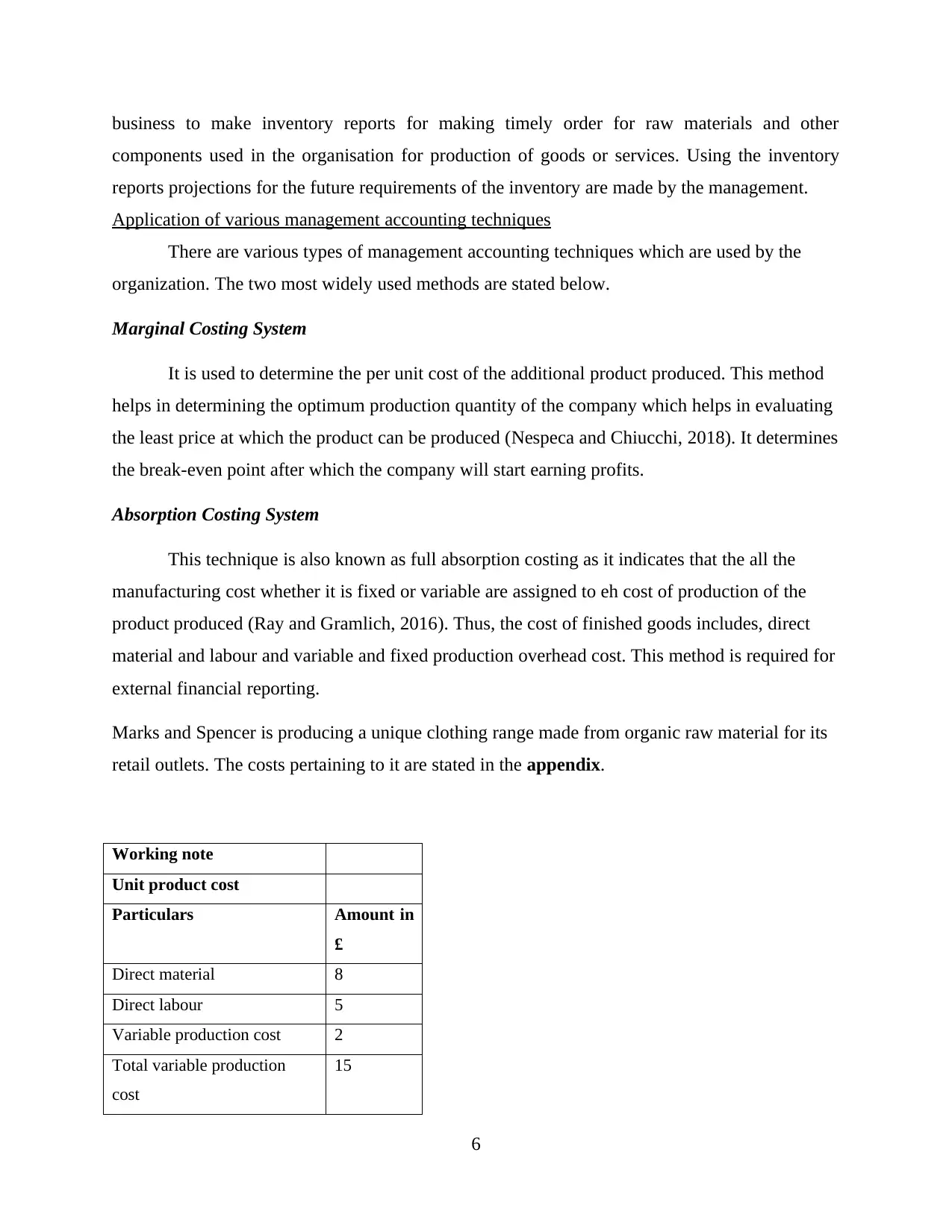
business to make inventory reports for making timely order for raw materials and other
components used in the organisation for production of goods or services. Using the inventory
reports projections for the future requirements of the inventory are made by the management.
Application of various management accounting techniques
There are various types of management accounting techniques which are used by the
organization. The two most widely used methods are stated below.
Marginal Costing System
It is used to determine the per unit cost of the additional product produced. This method
helps in determining the optimum production quantity of the company which helps in evaluating
the least price at which the product can be produced (Nespeca and Chiucchi, 2018). It determines
the break-even point after which the company will start earning profits.
Absorption Costing System
This technique is also known as full absorption costing as it indicates that the all the
manufacturing cost whether it is fixed or variable are assigned to eh cost of production of the
product produced (Ray and Gramlich, 2016). Thus, the cost of finished goods includes, direct
material and labour and variable and fixed production overhead cost. This method is required for
external financial reporting.
Marks and Spencer is producing a unique clothing range made from organic raw material for its
retail outlets. The costs pertaining to it are stated in the appendix.
Working note
Unit product cost
Particulars Amount in
£
Direct material 8
Direct labour 5
Variable production cost 2
Total variable production
cost
15
6
components used in the organisation for production of goods or services. Using the inventory
reports projections for the future requirements of the inventory are made by the management.
Application of various management accounting techniques
There are various types of management accounting techniques which are used by the
organization. The two most widely used methods are stated below.
Marginal Costing System
It is used to determine the per unit cost of the additional product produced. This method
helps in determining the optimum production quantity of the company which helps in evaluating
the least price at which the product can be produced (Nespeca and Chiucchi, 2018). It determines
the break-even point after which the company will start earning profits.
Absorption Costing System
This technique is also known as full absorption costing as it indicates that the all the
manufacturing cost whether it is fixed or variable are assigned to eh cost of production of the
product produced (Ray and Gramlich, 2016). Thus, the cost of finished goods includes, direct
material and labour and variable and fixed production overhead cost. This method is required for
external financial reporting.
Marks and Spencer is producing a unique clothing range made from organic raw material for its
retail outlets. The costs pertaining to it are stated in the appendix.
Working note
Unit product cost
Particulars Amount in
£
Direct material 8
Direct labour 5
Variable production cost 2
Total variable production
cost
15
6
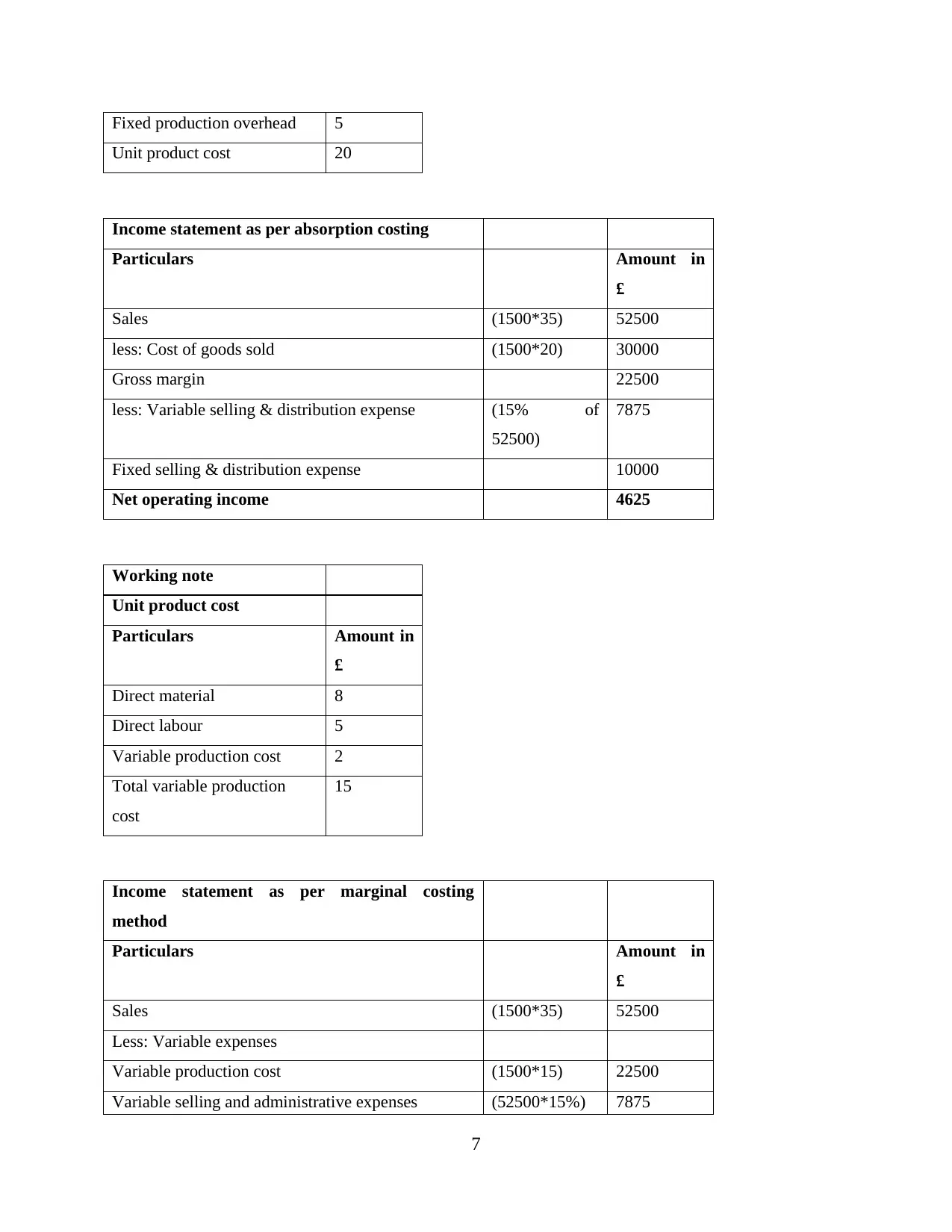
Fixed production overhead 5
Unit product cost 20
Income statement as per absorption costing
Particulars Amount in
£
Sales (1500*35) 52500
less: Cost of goods sold (1500*20) 30000
Gross margin 22500
less: Variable selling & distribution expense (15% of
52500)
7875
Fixed selling & distribution expense 10000
Net operating income 4625
Working note
Unit product cost
Particulars Amount in
£
Direct material 8
Direct labour 5
Variable production cost 2
Total variable production
cost
15
Income statement as per marginal costing
method
Particulars Amount in
£
Sales (1500*35) 52500
Less: Variable expenses
Variable production cost (1500*15) 22500
Variable selling and administrative expenses (52500*15%) 7875
7
Unit product cost 20
Income statement as per absorption costing
Particulars Amount in
£
Sales (1500*35) 52500
less: Cost of goods sold (1500*20) 30000
Gross margin 22500
less: Variable selling & distribution expense (15% of
52500)
7875
Fixed selling & distribution expense 10000
Net operating income 4625
Working note
Unit product cost
Particulars Amount in
£
Direct material 8
Direct labour 5
Variable production cost 2
Total variable production
cost
15
Income statement as per marginal costing
method
Particulars Amount in
£
Sales (1500*35) 52500
Less: Variable expenses
Variable production cost (1500*15) 22500
Variable selling and administrative expenses (52500*15%) 7875
7
⊘ This is a preview!⊘
Do you want full access?
Subscribe today to unlock all pages.

Trusted by 1+ million students worldwide
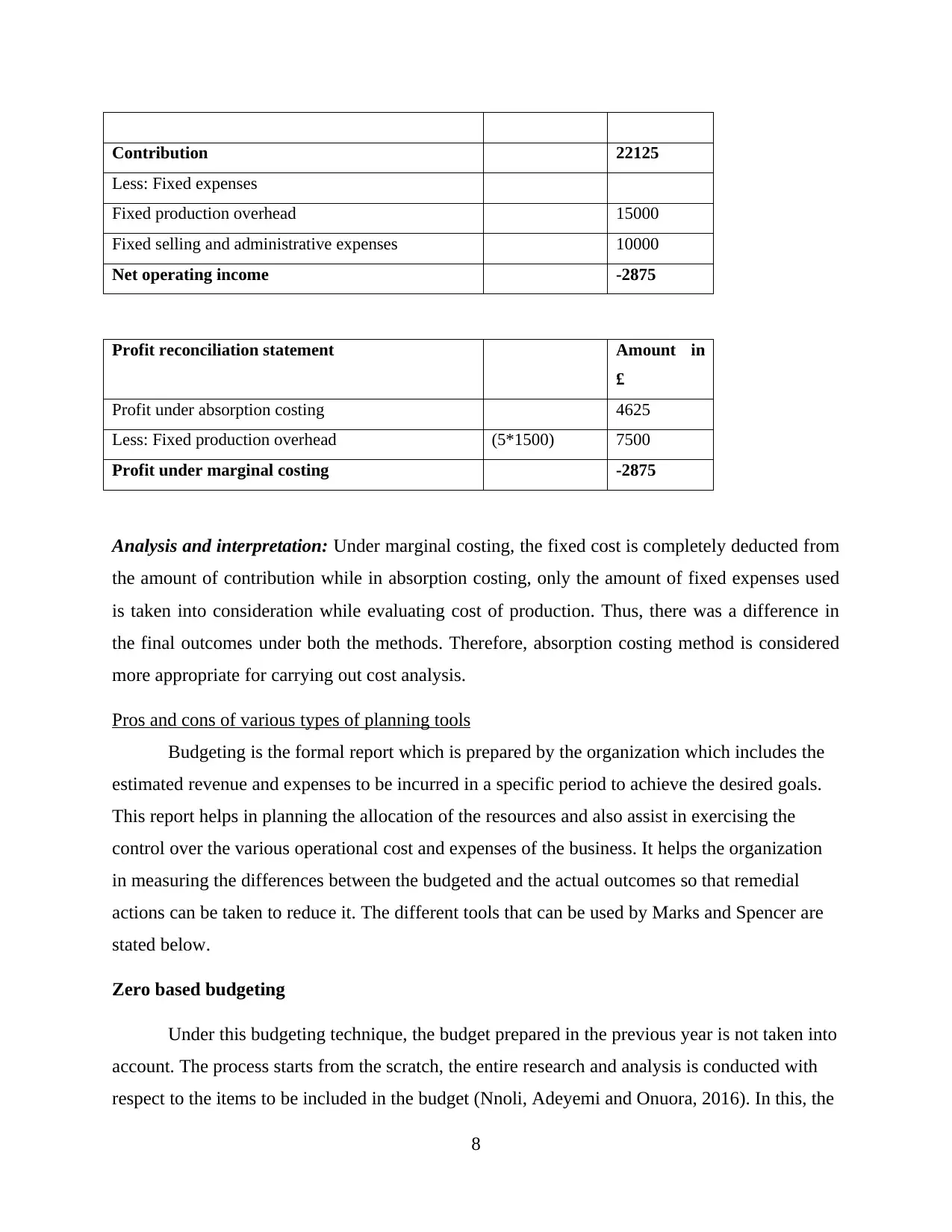
Contribution 22125
Less: Fixed expenses
Fixed production overhead 15000
Fixed selling and administrative expenses 10000
Net operating income -2875
Profit reconciliation statement Amount in
£
Profit under absorption costing 4625
Less: Fixed production overhead (5*1500) 7500
Profit under marginal costing -2875
Analysis and interpretation: Under marginal costing, the fixed cost is completely deducted from
the amount of contribution while in absorption costing, only the amount of fixed expenses used
is taken into consideration while evaluating cost of production. Thus, there was a difference in
the final outcomes under both the methods. Therefore, absorption costing method is considered
more appropriate for carrying out cost analysis.
Pros and cons of various types of planning tools
Budgeting is the formal report which is prepared by the organization which includes the
estimated revenue and expenses to be incurred in a specific period to achieve the desired goals.
This report helps in planning the allocation of the resources and also assist in exercising the
control over the various operational cost and expenses of the business. It helps the organization
in measuring the differences between the budgeted and the actual outcomes so that remedial
actions can be taken to reduce it. The different tools that can be used by Marks and Spencer are
stated below.
Zero based budgeting
Under this budgeting technique, the budget prepared in the previous year is not taken into
account. The process starts from the scratch, the entire research and analysis is conducted with
respect to the items to be included in the budget (Nnoli, Adeyemi and Onuora, 2016). In this, the
8
Less: Fixed expenses
Fixed production overhead 15000
Fixed selling and administrative expenses 10000
Net operating income -2875
Profit reconciliation statement Amount in
£
Profit under absorption costing 4625
Less: Fixed production overhead (5*1500) 7500
Profit under marginal costing -2875
Analysis and interpretation: Under marginal costing, the fixed cost is completely deducted from
the amount of contribution while in absorption costing, only the amount of fixed expenses used
is taken into consideration while evaluating cost of production. Thus, there was a difference in
the final outcomes under both the methods. Therefore, absorption costing method is considered
more appropriate for carrying out cost analysis.
Pros and cons of various types of planning tools
Budgeting is the formal report which is prepared by the organization which includes the
estimated revenue and expenses to be incurred in a specific period to achieve the desired goals.
This report helps in planning the allocation of the resources and also assist in exercising the
control over the various operational cost and expenses of the business. It helps the organization
in measuring the differences between the budgeted and the actual outcomes so that remedial
actions can be taken to reduce it. The different tools that can be used by Marks and Spencer are
stated below.
Zero based budgeting
Under this budgeting technique, the budget prepared in the previous year is not taken into
account. The process starts from the scratch, the entire research and analysis is conducted with
respect to the items to be included in the budget (Nnoli, Adeyemi and Onuora, 2016). In this, the
8
Paraphrase This Document
Need a fresh take? Get an instant paraphrase of this document with our AI Paraphraser
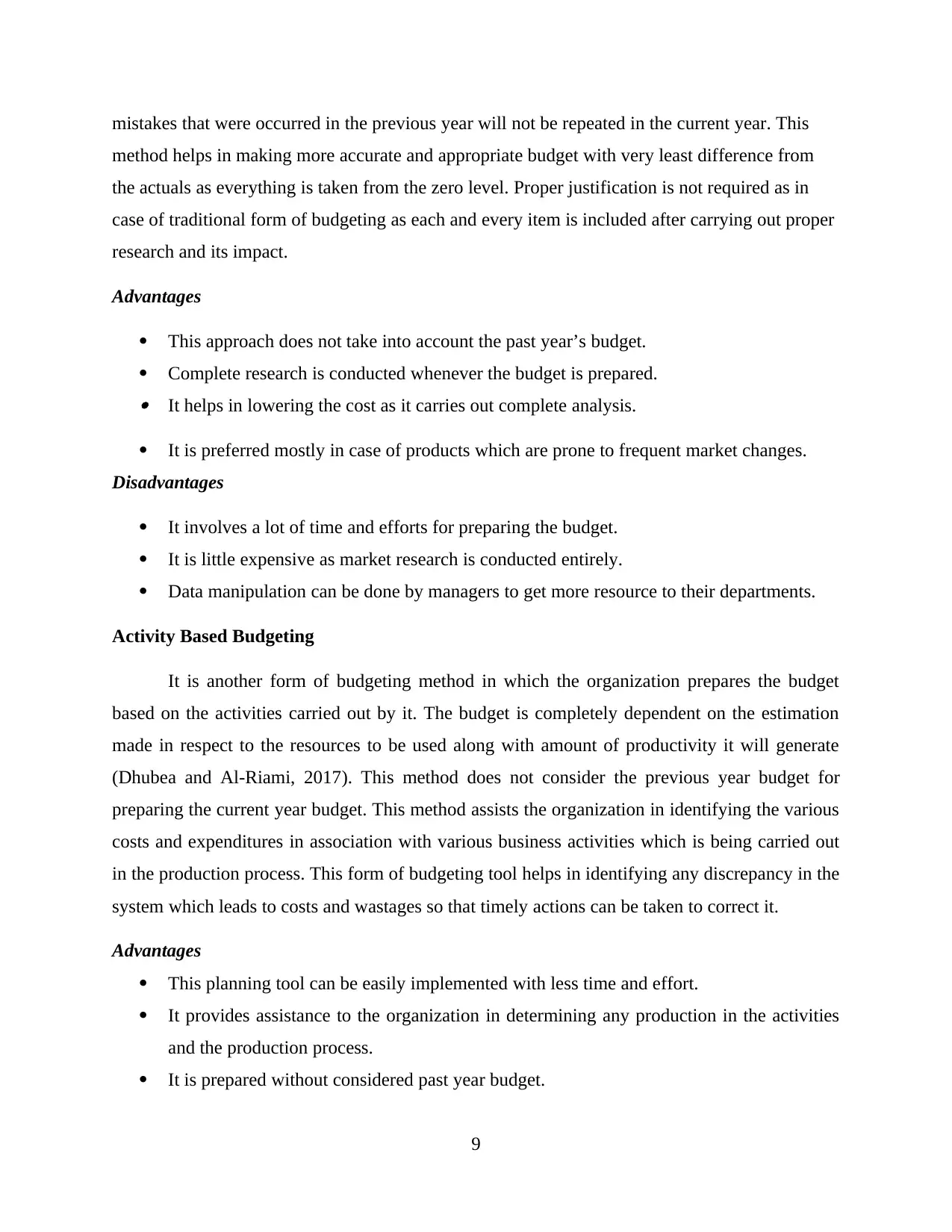
mistakes that were occurred in the previous year will not be repeated in the current year. This
method helps in making more accurate and appropriate budget with very least difference from
the actuals as everything is taken from the zero level. Proper justification is not required as in
case of traditional form of budgeting as each and every item is included after carrying out proper
research and its impact.
Advantages
This approach does not take into account the past year’s budget.
Complete research is conducted whenever the budget is prepared. It helps in lowering the cost as it carries out complete analysis.
It is preferred mostly in case of products which are prone to frequent market changes.
Disadvantages
It involves a lot of time and efforts for preparing the budget.
It is little expensive as market research is conducted entirely.
Data manipulation can be done by managers to get more resource to their departments.
Activity Based Budgeting
It is another form of budgeting method in which the organization prepares the budget
based on the activities carried out by it. The budget is completely dependent on the estimation
made in respect to the resources to be used along with amount of productivity it will generate
(Dhubea and Al-Riami, 2017). This method does not consider the previous year budget for
preparing the current year budget. This method assists the organization in identifying the various
costs and expenditures in association with various business activities which is being carried out
in the production process. This form of budgeting tool helps in identifying any discrepancy in the
system which leads to costs and wastages so that timely actions can be taken to correct it.
Advantages
This planning tool can be easily implemented with less time and effort.
It provides assistance to the organization in determining any production in the activities
and the production process.
It is prepared without considered past year budget.
9
method helps in making more accurate and appropriate budget with very least difference from
the actuals as everything is taken from the zero level. Proper justification is not required as in
case of traditional form of budgeting as each and every item is included after carrying out proper
research and its impact.
Advantages
This approach does not take into account the past year’s budget.
Complete research is conducted whenever the budget is prepared. It helps in lowering the cost as it carries out complete analysis.
It is preferred mostly in case of products which are prone to frequent market changes.
Disadvantages
It involves a lot of time and efforts for preparing the budget.
It is little expensive as market research is conducted entirely.
Data manipulation can be done by managers to get more resource to their departments.
Activity Based Budgeting
It is another form of budgeting method in which the organization prepares the budget
based on the activities carried out by it. The budget is completely dependent on the estimation
made in respect to the resources to be used along with amount of productivity it will generate
(Dhubea and Al-Riami, 2017). This method does not consider the previous year budget for
preparing the current year budget. This method assists the organization in identifying the various
costs and expenditures in association with various business activities which is being carried out
in the production process. This form of budgeting tool helps in identifying any discrepancy in the
system which leads to costs and wastages so that timely actions can be taken to correct it.
Advantages
This planning tool can be easily implemented with less time and effort.
It provides assistance to the organization in determining any production in the activities
and the production process.
It is prepared without considered past year budget.
9
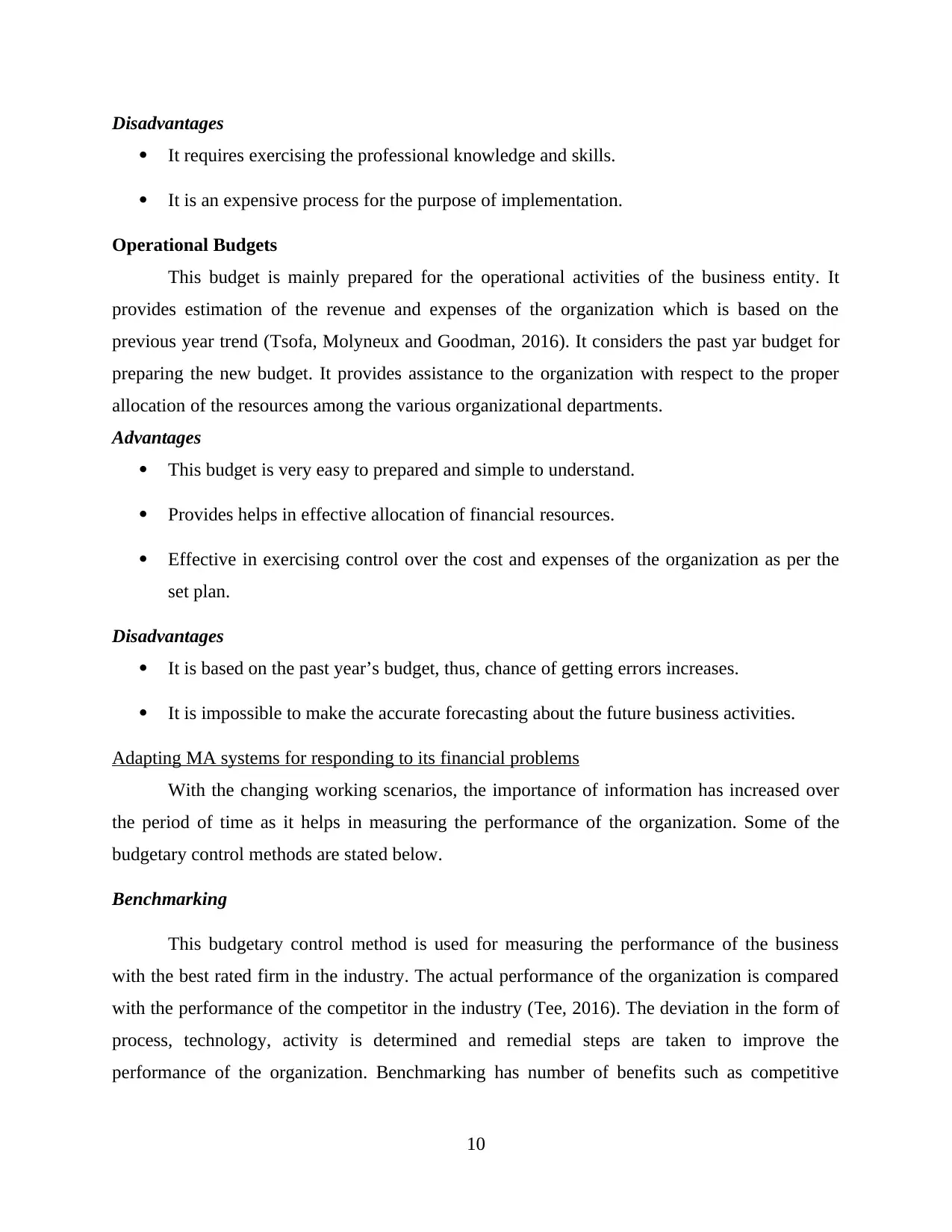
Disadvantages
It requires exercising the professional knowledge and skills.
It is an expensive process for the purpose of implementation.
Operational Budgets
This budget is mainly prepared for the operational activities of the business entity. It
provides estimation of the revenue and expenses of the organization which is based on the
previous year trend (Tsofa, Molyneux and Goodman, 2016). It considers the past yar budget for
preparing the new budget. It provides assistance to the organization with respect to the proper
allocation of the resources among the various organizational departments.
Advantages
This budget is very easy to prepared and simple to understand.
Provides helps in effective allocation of financial resources.
Effective in exercising control over the cost and expenses of the organization as per the
set plan.
Disadvantages
It is based on the past year’s budget, thus, chance of getting errors increases.
It is impossible to make the accurate forecasting about the future business activities.
Adapting MA systems for responding to its financial problems
With the changing working scenarios, the importance of information has increased over
the period of time as it helps in measuring the performance of the organization. Some of the
budgetary control methods are stated below.
Benchmarking
This budgetary control method is used for measuring the performance of the business
with the best rated firm in the industry. The actual performance of the organization is compared
with the performance of the competitor in the industry (Tee, 2016). The deviation in the form of
process, technology, activity is determined and remedial steps are taken to improve the
performance of the organization. Benchmarking has number of benefits such as competitive
10
It requires exercising the professional knowledge and skills.
It is an expensive process for the purpose of implementation.
Operational Budgets
This budget is mainly prepared for the operational activities of the business entity. It
provides estimation of the revenue and expenses of the organization which is based on the
previous year trend (Tsofa, Molyneux and Goodman, 2016). It considers the past yar budget for
preparing the new budget. It provides assistance to the organization with respect to the proper
allocation of the resources among the various organizational departments.
Advantages
This budget is very easy to prepared and simple to understand.
Provides helps in effective allocation of financial resources.
Effective in exercising control over the cost and expenses of the organization as per the
set plan.
Disadvantages
It is based on the past year’s budget, thus, chance of getting errors increases.
It is impossible to make the accurate forecasting about the future business activities.
Adapting MA systems for responding to its financial problems
With the changing working scenarios, the importance of information has increased over
the period of time as it helps in measuring the performance of the organization. Some of the
budgetary control methods are stated below.
Benchmarking
This budgetary control method is used for measuring the performance of the business
with the best rated firm in the industry. The actual performance of the organization is compared
with the performance of the competitor in the industry (Tee, 2016). The deviation in the form of
process, technology, activity is determined and remedial steps are taken to improve the
performance of the organization. Benchmarking has number of benefits such as competitive
10
⊘ This is a preview!⊘
Do you want full access?
Subscribe today to unlock all pages.

Trusted by 1+ million students worldwide
1 out of 17
Related Documents
Your All-in-One AI-Powered Toolkit for Academic Success.
+13062052269
info@desklib.com
Available 24*7 on WhatsApp / Email
![[object Object]](/_next/static/media/star-bottom.7253800d.svg)
Unlock your academic potential
Copyright © 2020–2025 A2Z Services. All Rights Reserved. Developed and managed by ZUCOL.





